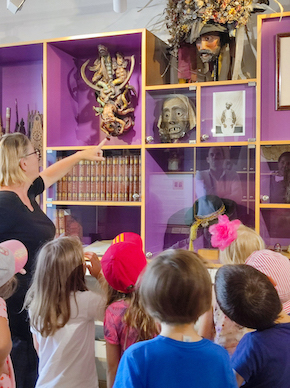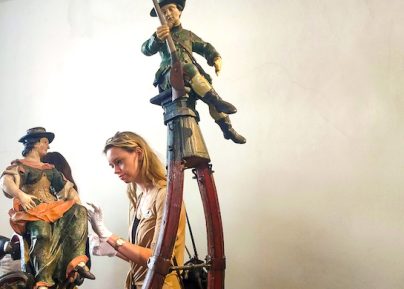Job shadowing at the Folklore Museum and the Weltmuseum Wien. For four weeks, Ulrike Schuhose was able to deepen her knowledge and methods of cultural mediation. How can citizens’ interest in visiting museums be aroused? What should museums change so that people see them as their places?
Impressions of my job shadowing from July 2-29, 2023
Folklore Museum Vienna
The museum is one of the largest European ethnographic museums with extensive collections on folk art as well as on historical and contemporary everyday cultures of Europe. It sees itself as an open place for research and education; there is room for current social issues and developments, social interaction and exchange. In their work of cultural mediation, the staff focus on lively and challenging approaches for children, young people and adults from different social groups.
In doing so, the Folklore Museum Vienna refers to the theses of Nora Sternfeld’s radical democratic museum: education is regarded as a fundamental human right. The museum’s goal is to make it accessible to people of all ages and social backgrounds. For an active, critical and participatory debate, it also offers regular discussions, conferences, guided tours, events, interventions, performative art, theatre projects, cooperation with NGOs, research and public science projects, online collections, online publications and mediation on its social media channels.
From 2020 to 2022, weltgewandt e.V. was a partner organisation within the framework of the Erasmus+ project “UNLOCK – United for those in Needs: Learn, Open, Care, Keep – the Museum Mediator as Diversity Integrator”, which brought together nine organisations (mostly museums) from five countries. The central concern was to break down barriers for people who – for various reasons – do not visit museums. During the project, an intensive exchange of knowledge began with employees of the Folklore Museum Vienna about education, cultural mediation and possibilities of opening up the museum to visitors who are considered disadvantaged and have so far taken advantage of what museums have to offer.
Inspired by the project and the discussions, we at weltgewandt e.V. implemented a project with residents in Marzahn. Together we went with them to various museums in Berlin in order to take away any fear of the threshold and to encourage them to develop their own questions. The visits were prepared and followed up using different methods. The participants captured their impressions of the explorations in photographs. This resulted in an exhibition that was shown for several months at the Marie Women’s Center. During the DIALOG cafés of weltgewandt e.V. in the Marzahn-Nord district, we also work with residents on questions of (everyday) culture. That’s why it was important for me to exchange experiences and insights into the conception and implementation of mediation projects with other colleagues and thus to train and develop myself as a trainer.
The intensive exchange with colleagues, the participatory observation of museum tours, participation in workshops and other activities made it possible to gain intensive insights into museum and educational work, to help develop museum educational interventions and to work with different target groups.
An example: “When the world came to Vienna and soy to Europe”. At the time of my job shadowing, the exhibition on the soybean plant was running. At the 1873 World’s Fair in Vienna, the crop production expert Friedrich Haberlandt discovered it for himself and his science. From the Schönborn Garden Palace, the building of today’s museum, he started the first cultivation attempts of this plant, which for him was associated with high expectations in the areas of public nutrition and economics. For the exhibition, I developed interactive (guerrilla) elements with the museum educators, which on the one hand drew attention to the exhibition in the museum garden and park, and on the other hand reflected on the cultivation of the soybean. I documented the growth of the soybean plants and wrote texts for the museum’s social media presence.
Weltmuseum Wien
In the last week of my working stay, I worked in the education department of the Weltmuseum Wien, previously the Museum of Ethnology. This is the ethnological museum at the Vienna Hofburg – in the middle of the tourist hot spot. The World Museum contains collections from all continents. It also has a library, an archive and an important collection of photographs. Here I was able to get to know newer methods of cultural mediation: Performance, storytelling, acoustic, sensual and mindful perception – often combined with creative work in just 90 minutes.
Conclusion
My job shadowing in both museums has been an enriching, inspiring and educational experience. I was able to expand my knowledge of European cultural history as well as gain knowledge and methodological suggestions in the areas of education, communication and the conception of educational offers. In the exchange at eye level with the wonderful, temporary Viennese colleagues, the learning was not only one-sided, but at the same time I was able to pass on my experience and knowledge to my colleagues.
During the four weeks, I was able to deal more intensively with the history and culture of another European country. I also learned how educational impulses can actually stimulate visitors to learn new things and question their thinking. Such mediation can set something in motion – in the individual and in society. This can – in a gentle dose – satisfy the radical democratic claim that a museum has an emancipatory function.
You can read the full report via this link.



